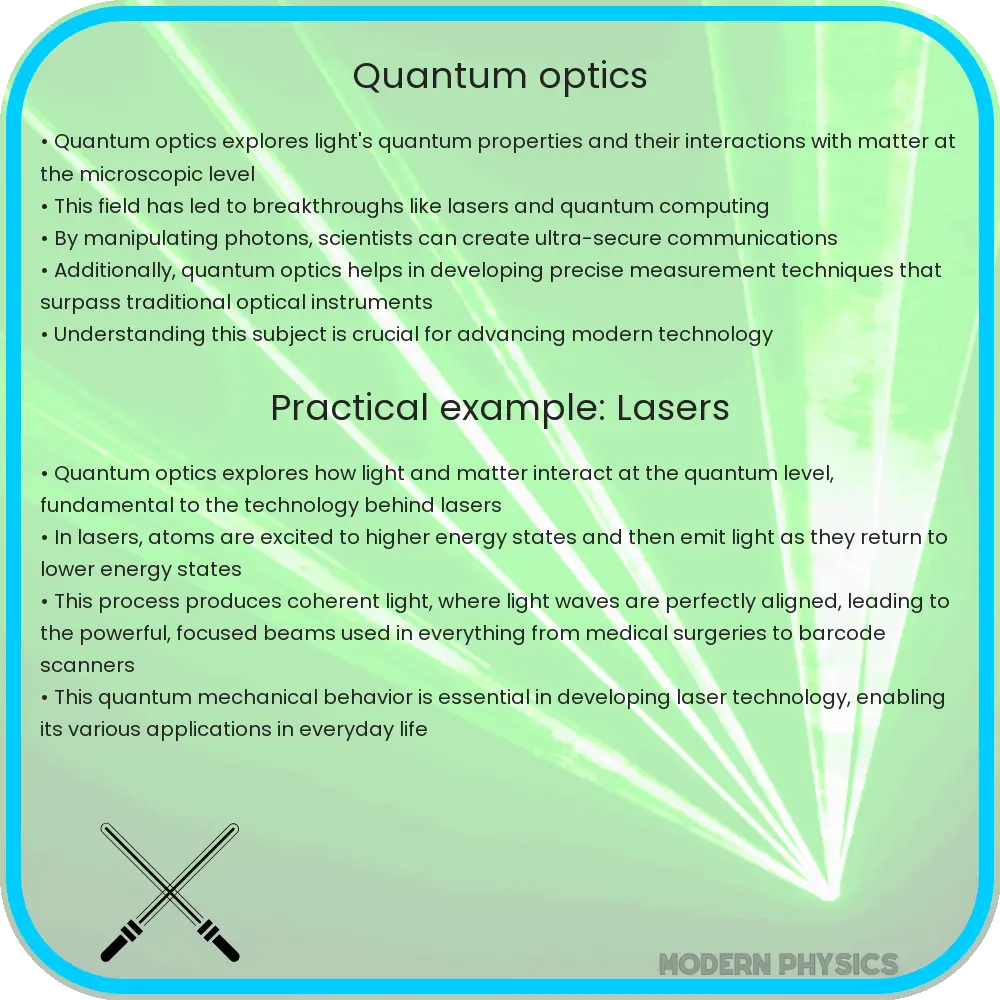Explore the transformative world of Quantum Optics, its principles, and groundbreaking applications in computing, communication, and imaging.

Understanding Quantum Optics: A Journey into Cutting-Edge Precision and Innovation
Quantum Optics, an intriguing field at the intersection of quantum physics and optics, explores the fundamental properties of light and its interaction with matter at the quantum level. This field has become pivotal in advancing our understanding of quantum mechanics and has led to revolutionary applications in various domains.
Principles of Quantum Optics
At the heart of Quantum Optics is the concept of light as both a wave and a particle, a duality central to quantum mechanics. Quantum Optics studies phenomena like photon entanglement, quantum superposition, and quantum coherence. These concepts, while abstract, have profound implications in practical applications such as quantum computing, secure communications, and advanced imaging technologies.
Photon Entanglement and Quantum Superposition
Photon entanglement, a phenomenon where pairs or groups of photons are generated or interact in ways such that the quantum state of each photon cannot be described independently of the state of the others, is a cornerstone of Quantum Optics. Similarly, quantum superposition allows particles like photons to exist in multiple states simultaneously, leading to the potential for incredibly complex computing operations.
Applications in Cutting-Edge Technologies
Quantum Optics has led to the development of groundbreaking technologies. One of the most notable is Quantum Computing, which uses the principles of quantum superposition and entanglement to perform operations on data at speeds unimaginable with classical computers. Another application is in Quantum Cryptography, where the principles of Quantum Optics are used to create secure communication channels, virtually immune to eavesdropping.
Advanced imaging techniques, such as Quantum Microscopy and Quantum Telemetry, also owe their inception to Quantum Optics. These technologies allow for unprecedented precision and resolution, far beyond the capabilities of traditional optical systems.
In the medical field, Quantum Optics is paving the way for new diagnostic tools and treatments. For example, techniques based on quantum fluorescence are being developed for more accurate and early detection of diseases.
The exploration of Quantum Optics has not only expanded our understanding of the quantum world but also opened up avenues for innovation in technology and science. Its applications are vast and continue to grow, demonstrating the limitless potential of merging quantum mechanics with optical science.
As we delve further into the complexities and possibilities of Quantum Optics, it’s clear that this field will play a crucial role in shaping future technologies and scientific advancements. Its implications in computing, communications, imaging, and even medicine highlight its versatile and transformative nature.
Advancements in Quantum Optics and Future Prospects
The field of Quantum Optics is not just limited to theoretical research; it has tangible real-world applications that are transforming industries. In telecommunications, the development of quantum networks promises to enhance security and data transmission speeds, leveraging the principles of quantum entanglement and superposition. In computing, quantum optical systems are integral to the evolution of quantum computers, which promise to solve complex problems far beyond the reach of classical computers.
Challenges and Innovations
Despite its potential, Quantum Optics faces significant challenges. One of the primary hurdles is the delicate nature of quantum states, which are easily disturbed by the environment—a phenomenon known as quantum decoherence. This poses a significant challenge in maintaining stable quantum states, which is crucial for practical applications. Researchers are continuously developing innovative techniques to overcome these challenges, such as using special materials or extreme conditions like ultra-low temperatures to preserve quantum coherence.
Another challenge is scalability, especially in quantum computing and networking. Creating and maintaining entangled states over long distances or among many particles requires highly precise control and stability. Innovations in optical technology and materials science are playing a crucial role in addressing these scalability issues.
The Future of Quantum Optics
Looking towards the future, the potential applications of Quantum Optics are vast. One exciting prospect is the development of quantum sensors, which could allow for measurements with unprecedented precision. These sensors could revolutionize fields from navigation to geological exploration. Additionally, the integration of quantum optical systems in space technology could lead to the development of new communication systems and deep-space exploration tools.
Quantum Optics is also contributing to the fundamental understanding of the universe. By probing the quantum nature of light and its interaction with matter, scientists are gaining new insights into the fundamental laws that govern our world.
Conclusion
In conclusion, Quantum Optics stands at the forefront of modern science and technology. Its unique blend of quantum mechanics and optics has led to extraordinary advances and promises even more for the future. From revolutionizing computing and secure communications to advancing medical diagnostics and deepening our understanding of the universe, Quantum Optics continues to be a driving force of innovation and discovery. As we move forward, the continuous exploration and application of this field will undoubtedly shape the landscape of technology and science in unprecedented ways, marking an era of precision, innovation, and cutting-edge development.
